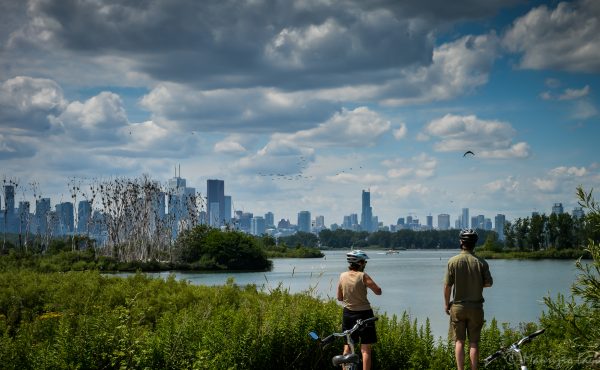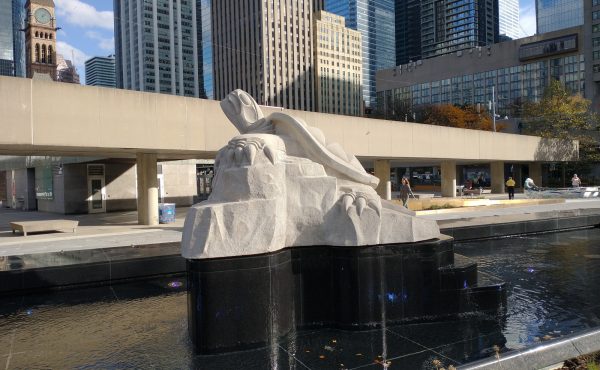I’ve been cycling to my job at the University of Toronto for several years now, and each year there have been a few more bikes parked there. But when I arrived on the first day of classes this year at the beginning of September, the sight was astonishing — there were bikes everywhere, fillling up not only the local ring-and-posts but also every signpost available (there are some locked to the posts for the parking spot numbers in the distance, too). It continued like this all month.
It’s not just the students, either — I know more and more professors and university staff members who are riding their bikes to work.
I’ve been observing this trend for the past year in the downtown core during the cycling-friendly months — bikes taking up every possible bike parking space wherever there is a work destination. It’s not just places where you’d expect a lot of people to bike to work (like 215 Spadina, where Spacing‘s offices are), but around all kinds of office areas downtown. It’s one of the signs that cycling has really taken off as a mode of transportation in the last couple of years.
It goes to show that the anti-bike rhetoric of some mayoral candidates is missing the boat. Cycling is already ensconced as a basic part of the transportation network in the central part of Toronto. And it’s a direction that many other large cities around Canada and the world are also headed towards, whether it’s Montreal, New York or London. It makes sense not just for health and environmental reasons, but also simply from the standpoint of transportation efficiency — you can carry more people on the same amount of road if you can get lots of them cycling, because bikes take up less space than cars (plus, bike lanes cost less than additional transit).
For the most part, this has been true in Toronto — the increase in cycling has not detracted from other ways of getting to work, but simply added capacity to existing roads. Usually, bike lanes have been added to streets in Toronto simply by squeezing unneccesarily wide vehicle lanes into narrower ones, not removing them, which does not reduce vehicle capacity (there is possibly a slight reduction in potential speed, but no-one is travelling fast in rush hour anyway), along with in some cases removing a small number of parking spaces. The Jarvis bike lanes, where a lane of motor vehicle traffic was removed to make way for them, were anomalous — but, unfortunately, their media prominence has created an inaccurate impression in some people’s minds of the impact of bike lanes as a whole. The reality is that, in most cases, bike lanes have enabled the same amount of road to carry more people — the same number of vehicles as before, plus bikes as well. If anything, they have helped mitigate increasing congestion by absorbing more capacity as the number of commuters heading downtown increases, expecially during the summer months when Toronto is most susceptible to smog.
To me, a good example of how to integrate bike lanes into a crowded city is the recently completed Wellesley bike lanes, which I have recently started using to get to work. While most of Wellesley is wide enough for bike lanes, like many city streets it’s erratic. Rather than giving up on the idea, or having ridiculous bits of unconnected bike lane, the Wellesley lane adapts to the street by using sharrows to link the sections of lane together where the road is too narrow for a full lane — and also, going east at Bay, to indicate to cyclists to avoid the right-turn lane, where they would get in the way of turning cars. I’ve found that the presence of sharrows is usually enough to get cars to leave enough space for bikes, and also to remind them to look out for bikes and accommodate them. Essentially, bikes have been integrated into the street without significantly interfering with its use by cars (or buses) — increasing its overall capacity.
As well as bike lanes, though, the sight of bikes spilling over every possible parking spot is a reminder that the City also needs to continually increase the amount of bike parking available in order to absorb the increasing number of cyclists. In addition to ring-and-posts, the requirements in the new zoning bylaw that new buildings have to provide bike parking, and ideas like converting on-street parking spots to bike parking where there is demand, are not just nice ideas, but long-term neccessities.





10 comments
It’s true, there’s suddenly bikes everywhere.
I knew the new, hip bar opening 2 doors away from me was finally open when the street was suddenly covered in parked bikes on a Friday evening (it’s the kind of bar that was too hip to have any kind of signage for the first couple of weeks). There is definitely a change afoot – 10 years ago, no one rode their bike to the bar. Now everyone does.
Good photo — I think my bike was probably parked there when it was taken!
I have seen the larger number of bikes, and hope the limited Bixi plan helps. I am a cyclist too, but maybe I am just too much older than you to share so much optimism.
“It goes to show that the anti-bike rhetoric of some mayoral candidates is missing the boat.” You are forgetting that Toronto has an average density the same as LA, so that the bikeable downtown accounts for only a portion of the city. Also white people over fifty in the inner suburbs vote, consistently; they also drive.
“I’ve found that the presence of sharrows is usually enough to get cars to leave enough space for bikes, and also to remind them to look out for bikes and accommodate them.” I don’t think we have come across the same Toronto drivers! Here in Tokyo they have little of the infrastructure, but it is far safer. And forget about cultural arguments, it has much more to do with the police/court assumption that the driver is always at fault.
james: Toronto also has the same density as Copenhagen. There are different ways in which the landscape can shape the city and have an effect on travel. LA has so many highways there is no reason to bike.
South of St Clair, Toronto can truly become a bike city. We just have to keep trying to convince civic leaders of this. Showing photos, and producing reliable data, will win over the mushy middle.
When visiting 215 Spadiina this past week I could find no place to tie up my bike. The racks, in the car parking spot recently added, were packed as was every other rack and pole nearby.
My only option in the immediate area: a guy wire holding up a utility pole.
It looks as if another car parking spot is needed to be converted for bike parking.
http://www.flickr.com/photos/42138535@N07/
Along with the increased numbers of bikes, I’m seeing more pedestrian-cyclist problems around U of T. I’m on campus once a week, and twice within the past couple of months I’ve seen a cyclist nearly hit a pedestrian (in both cases, the pedestrian was crossing at a marked crosswalk). I was almost hit myself by a cyclist who wasn’t paying attention while running a red light.
Yes! It’s crazy, I’ve attended UofT for years, and can’t remember it ever being this full. I go to OISE, and in the morning, I regularly have to cruise down the street looking eagle-eyed for a post with only one bike on it. When I twisted my ankle in badminton, and walking hurt (but biking was fine), I actually wished there was a “handicapped parking” for bikes 🙂 It’s funny, the idea of circling a block looking for parking has just never occurred to me before as a biker.
Anyway, I’m of course super-happy to see more bikes, but I also hope that there is more bike parking spots put in.
(And I really hope the Bloor “beautification” project gets finished soon – although that’s not very relevant)
It’s great to see non-student/artsy places clogged with bikes as well. Scotia Plaza’s bike parking area must grow 50% each year, and it can be quite full.
Yes, soo many bikes, so little civic response… and it’s quite encouraging. But the City, even in allegedly pro-bike wards and with a reputed pro-bike council is not responding well enough to bike numbers, let alone climate change.
– the Wellesley lane was first talked about late 70s, and yes, now it’s in, but we still have connectivity issues at Queen’s Park and at Parliament, and the City still has not fixed/adjusted where the eastwards lane narrows to 1.2M at a danger point of a rightwards curve east of Jarvis – and it seems somehow they couldn’t measure the road width, or didn’t, and tried to blame painters.
– Harbord St. has a four-block gap between Borden and Spadina, and the local councillor and the CU are content with putting in sharrows, and don’t have the gumption to fill up the gap catering to merchants who don’t have the same pull as Dupont St. merchants.
– oh Mr. Vaughan and the City and CU will point out the new efforts coming to put in bike boxes on Harbord and College – and it will likely help – but we need continuity of the bike lanes first and foremost, including up to the major intersections first, and we don’t yet know if that’s occurring.
– and then there’s the ongoing disaster of Bloor St. – which has been a slow-motion torture given how the whole project and process has been privatized, and neglects bikes and bike safety while squandering the great opportunity for easy bike lanes by wasting needed space between new granite curbs and new granite planters. To see how readily our roads can be fixed up after rebuilding at multi-millions, take a ride on Spadina, where the civic processes couldn’t find the room for bike lanes there either, and most of those guys are still working for “us”.
– the new paving of the curb lanes of Harbord is questionable west of Bathurst to Ossington, given the quality of the road was OK, and the crap riding conditions in soo many other areas of the City continue, including where some bike lanes are supposed to go in, maybe this year, maybe next, who knows – the stuff from over a year ago still isn’t here yet, and is part of it from some politicians now running again?
Improvements to biking to UofT are long overdue, and the dominant travel direction and crash pattern is east-west – but the city isn’t responding, or not responding well enough – ongoing liabilities folks! though some of us bike riders can be non-stop quick and quiet “passholes”… that are hard to advocate for.
It’s too bad that photos and anecdotes are all we have to draw on to point out that cycling numbers are up.
There is hope, I saw a city vehicle counting station set up in the College st. bike lane a few months back. Here’s to getting official statistics – hope it is more widespread than one measuring point.